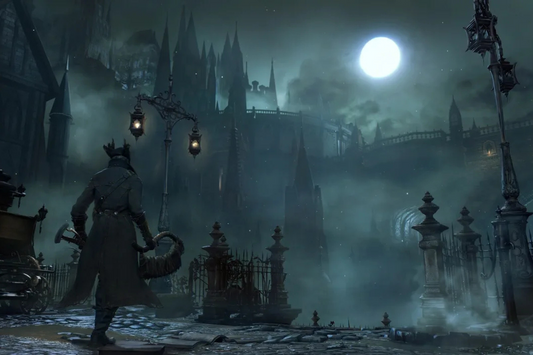In a world teeming with monstrous adversaries, haunting landscapes, and intricate lore, few figures in Elden Ring command as much reverence and fear as Malenia, Blade of Miquella. Though technically an optional boss, Malenia is widely regarded by the Elden Ring community as the game’s true final challenge. Her presence in the game is more than just another hurdle—it represents a culmination of the game's design philosophy: beauty, brutality, and tragedy intertwined.
The Origins of Malenia
Malenia is the daughter of Queen Marika the Eternal and Radagon, making her a demigod and twin sister to Miquella. From birth, Malenia was afflicted with the curse of the Scarlet Rot—a corruptive force that slowly eats away at both the body and the land. Despite this debilitating curse, she rose to become one of the most powerful warriors in the Lands Between, wielding her katana with unmatched elegance and ferocity.
Unlike many other demigods, Malenia’s motives were not driven by a thirst for power. Her devotion was primarily to her brother, Miquella, a similarly cursed figure who sought to create a world free of the influences of the Greater Will. In her role as his protector, Malenia became both a warrior and a symbol of tragic nobility.
The Haligtree and Malenia’s Purpose
After the Shattering, Miquella began cultivating the Haligtree, an alternative to the Erdtree meant to harbor those cast aside by the dominant powers of the world. Malenia stationed herself within Elphael, at the base of the Haligtree, as its sword and guardian. Her presence there is both protective and symbolic—representing her undying loyalty to her brother’s dream and her isolation from the wider conflicts of the world.
As players journey through the decaying grandeur of Elphael, they encounter a world corrupted and in decline, mirroring Malenia’s own state. The Scarlet Rot that once devastated Caelid now eats away at her sanctuary. It’s a grim foreshadowing of the battle to come.
The Battle with Radahn: A Turning Point in the World
Malenia’s most notable contribution to the wider world of Elden Ring comes through her infamous battle with General Radahn. In one of the most pivotal events in the game’s lore, these two demigods clashed in the Wailing Dunes. Neither emerged victorious, but the devastation they wrought was permanent.
Radahn, driven mad by rot and starved of sanity, continued to roam the wastelands of Caelid. Malenia, having unleashed the Scarlet Rot to gain the upper hand, was carried away by her Cleanrot Knights to recover. The battle left Caelid in ruins, permanently reshaping the region and its inhabitants. This duel not only shaped the geography but also solidified Malenia's legend as a force capable of altering the world through her will alone.
A Boss Fight Unlike Any Other
Malenia is not just another endgame challenge. She is the boss that tests every skill you’ve acquired across your journey. Her elegance is deceptive. What begins as a rhythmic duel quickly escalates into a life-or-death sprint.
In her first phase, Malenia attacks with swift katana slashes, often chaining long combos and catching players who aren’t constantly alert. One of her signature abilities, the Waterfowl Dance, is a whirlwind of death that punishes hesitation or poor positioning. If that weren’t enough, she regenerates health with every successful strike she lands, which means defensive play alone isn’t enough—aggression is mandatory.
Then, just when victory feels near, Malenia reveals her second form: the Goddess of Rot. Transformed, she unleashes devastating area-of-effect rot attacks, can summon phantom versions of herself to dive bomb the battlefield, and becomes even more relentless. It's in this phase that her battle becomes not just mechanical but psychological. It demands perseverance, adaptability, and the will to endure.
Strategies for Overcoming Malenia
Malenia may be the most difficult boss in Elden Ring, but she’s not unbeatable. Preparation is key. Weapons that deal bleed damage, like katanas or curved swords, can help chip away at her health quickly. Spells and ashes of war that stagger her or provide rapid damage bursts are particularly valuable.
Summoning Spirit Ashes like Black Knife Tiche or the Mimic Tear can shift the odds in your favor, creating openings for strikes or drawing her aggro. Equally important is managing your stamina and learning her attack patterns—especially in the first phase where baiting out the Waterfowl Dance and punishing her afterward can be a game-changer.
Persistence is everything. Victory against Malenia is earned, not given. And that’s what makes her encounter so memorable.
A Symbol of Beauty and Decay
Malenia’s design is a haunting contradiction. She is beautiful, graceful, and noble—but also rotting, corrupted, and violent. This duality reflects the game’s broader themes of decay, ambition, and resilience. She is a reflection of the world around her: once grand, now broken, but never without purpose.
Her backstory elicits sympathy. She fights not for glory or domination but out of love and loyalty. Unlike other bosses who succumbed to madness or greed, Malenia’s tragedy is that she remains sane and purposeful even as the rot consumes her.
The Community and Malenia’s Impact
Few bosses in gaming history have captured the attention and respect of a community quite like Malenia. From fan art and cosplay to entire YouTube channels dedicated to strategies for defeating her, Malenia has become a cultural icon.
Perhaps the most legendary example is the player known as "Let Me Solo Her," who became famous for repeatedly defeating Malenia on behalf of others, wearing nothing but a jar helmet and a loincloth. This kind of communal mythology is rare and speaks volumes about the impact Malenia has had on the game’s legacy.
Why Malenia Is the True Final Boss
Although Elden Ring has a canonical final boss, many players consider Malenia the true final challenge. She embodies everything the game is about: combat depth, lore richness, visual beauty, and emotional weight. She is not just a boss to defeat but a character to understand.
Beating her feels less like completing a mission and more like conquering the soul of the game itself. It’s an emotional, grueling, and deeply rewarding experience that stays with players long after the credits roll.
Conclusion
Malenia, Blade of Miquella, is more than just a difficult boss. She is a masterpiece of design, lore, and symbolism. Facing her is a rite of passage in Elden Ring, a confrontation that challenges your skills and your patience in equal measure. But more than that, she stands as a tragic testament to love, rot, and resilience.
For those who seek the heart of what Elden Ring offers—not just the thrill of battle, but the depth of meaning—Malenia is the true final boss. And conquering her is the moment where your legend as the Tarnished is truly born.








